Related Blogs
Table of Content
- Why Do We Need Reactive Programming?
- What are Reactive Systems?
- What Does Reactive Manifesto Mean In Reactive Systems?
- Difference Between Reactive Programming and Reactive Systems
- Java Reactive Programming, How is it Done?
- Reactive Programming Benefits
- When to Use Reactive Programming?
- When Not to Use Reactive Programming?
- General Significance of Reactive Programming
- Summary

Reactive programming is a programming model for constructing asynchronous and non blocking elements. It is a trending topic right now, and there’s a lot of chatter going around it. However, as a Java development company we are always ready to clear the doubts surrounding new Java topics and trends. Although this will also help our clients to know more about Java Reactive programming.
Some ideas might disappear over time, only to reappear as new ideas when you apply them to a different setting. The identical situation has occurred with Java reactive programming.
What is the definition of reactive programming? What advantages can reactive programming provide as Java applications? Let’s delve further into this subject, relate it to imperative programming, and emphasize the benefits of this programming style for both apps and businesses.
The terms Java Reactive Programming and Functional Reactive Programming (FRP) are common. Even though they are fundamentally distinct, the notions of concurrent programming and excellent performance are often confounded with reactive programming to the point where it is difficult to distinguish them. The result is certain chaos.
Many believe that Reactive is just another version of what they already do every day (mostly they use JavaScript). Some others attribute it to Microsoft, which just made a huge deal out of releasing C# enhancements. There has been a lot of talk about Reactive Streams and other similar projects in the Enterprise Java community as of late. However, there are many misconceptions regarding the appropriate contexts in which to employ these technologies. Let us get a clearer picture of that!
1. Why Do We Need Reactive Programming?
Asynchronous programming is often useful to make systems quick and responsive when dealing with large amounts of data or multiple users. Especially with Java, which is a throwback to the early days of object-oriented programming, asynchronicity may cause a lot of problems and make the code difficult to comprehend and maintain. Consequently, in this strictly object-oriented context, reactive programming is hugely useful since it streamlines the management of asynchronous processes and deals with asynchronous data streams.
Meanwhile, we will also focus on how Reactive Programming serves as a catalyst for developing a Reactive System to help us comprehend the logic behind this creation better.
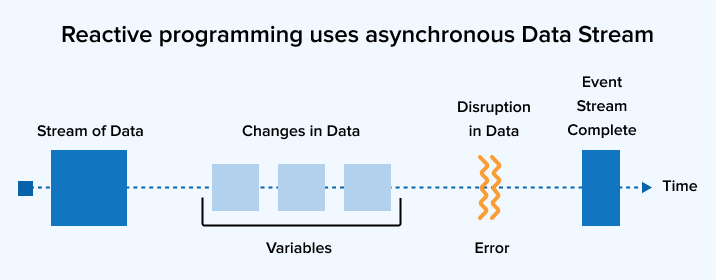
2. What are Reactive Systems?
A reactive system is an architectural style that allows applications to compose multiple microservices to work together, reacting to their surroundings and one another. Such systems are designed to be more responsive, elastic, and resilient by using asynchronous message-driven communication, which can be helpful features for various applications.
Basically, it is a computer systems paradigm that takes advantage of the flexibility and responsiveness provided in reactive programming so that databases, servers, and software applications can continue to thrive if any of the components is compromised.
Apart from this, it provides productivity for Architects and DevOps at the system level and allows you to build large-scale distributed systems. Also, reactive systems are useful to work with Reactive Programming within the components of a Reactive System.
3. What Does Reactive Manifesto Mean In Reactive Systems?
The Reactive Manifesto was created in 2013 by a group of developers led by Jonas Boner to describe a set of fundamental principles. This is the premise upon which the architecture style necessary to develop Reactive Systems was established. This manifesto has now garnered considerable attention in the programming world.
This document lays out the steps necessary to create a scalable, adaptable, and loosely-coupled reactive system. This paves the way for simple development, fault tolerance, and most all, high responsiveness, all of which are necessary for creating amazing user experiences.
The manifesto lays forth the defining features and guiding ideas of a reactive system, including:
- Responsive: A reactive system’s quick and constant reaction time, and by extension, service quality, is what makes it reactive.
- Resilient: A reactive system should be robust if it is to continue responding in the face of random breakdowns.
- Elastic: An elastic system is one that can accommodate fluctuating loads without incurring excessive costs.
- Message-driven: It must rely on the exchange of asynchronous messages between various parts of the system.
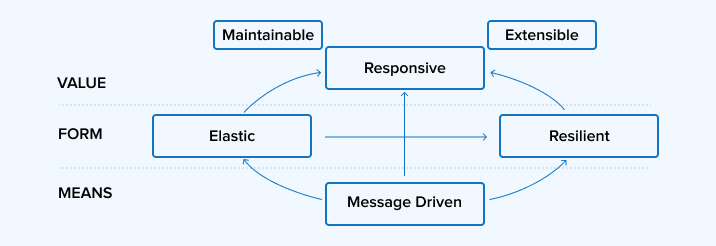
Although these ideas make perfect sense, applying them to complicated corporate architecture may be difficult. Here we’ll build a simple Java system that exemplifies these guidelines.
4. Difference Between Reactive Programming and Reactive Systems
They are not. In fact, they are commonly used interchangeably, these phrases really mean different things.
To take ‘reactivity’ to its logical conclusion, we have reactive systems. In order to develop software applications that are robust, versatile, and responsive, a number of architectural and design choices must be made at this stage.
In reactive systems, using reactive programming is not required but recommended since it increases the advantages your software receives from both approaches, such as loose coupling, better use of system resources, faster response times, and reduced latency.
5. Java Reactive Programming, How is It Done?
The Reactive Programming has less of an impact on available memory while delivering better performance for Java programs. It’s accomplished by avoiding OS process and context transitions caused by blocked calls.
Since the number of users and the complexity of their requests have grown, it is desirable to implement the Reactive Programming strategy in modern web applications. Program execution is viewed as an asynchronous series of events in Reactive Programming.
The core reactive components of Java reactive programming are as follows:
- Observables (a data source/stream that may emit zero, one, or more values; may also produce mistakes; may have a finite or indefinite length);

- Users (those who have subscribed to an Observable in order to take use of the data it provides and receives notifications of any failure or success);
- Build, modify, analyze, and integrate Observables with the help of Operators;
- Schedulers that enable us to add concurrency to our Observables and Users without difficulty.
Data streams that carry actions, requests, notifications, and failures will form the backbone of your application while utilizing reactive programming. You may monitor the streams using Reactive Programming and act whenever a value is delivered. The developer generates streams in the code for everything that might change or occur (click events, cache events, HTTP requests, etc.), turning the program into an asynchronous one.
There has been a lot of activity required in providing Reactive layers on top of the JDK. Let’s take a look at a few of them.
ReactiveX
ReactiveX (Reactive Extension) provides a fantastic toolset for incorporating Reactive Programming modules into an application and composing asynchronous, event-driven applications with an observable series.
Reactive Streams
Reactive Stream is an inferior contract defines as a handful of Java interfaces but is also suitable for other languages. It is an initiative to deliver a prototype for the asynchronous stream that is processed with non-blocking explicit back pressure and assembles a standard language for interoperable libraries.
Reactor
Reactor is a fourth-generation Java framework from the Pivot open-source team that is based on Reactive Streams. It allows you to build directly on Reactive Streams, so you don’t require to form a bridge.
Spring Framework 5.0
Spring Framework 5.0 provides comprehensive programming for modern Java-based enterprise applications. It is an open-source platform that aims to simplify the complex Java application development process. It has several built-in reactive features which include tools for creating HTTP servers and clients.
Ratpack
Ratpack is a collection of JVM-based libraries that are useful for building high-performance services over HTTP. It is developed on a Netty event-driven networking engine with the reactive design pattern and implements Reactive Streams for interoperability.
Akka
Akka is a source-available toolkit for building concurrent applications on the JVM. According to David Karnok, it is a third-generation library that supports various programming models for concurrency that exist for both Scala and Java.
There are a variety of libraries available nowadays (Rx, Spring, etc.) that make it possible to include reactive programming into your project using various techniques and frameworks.
Take a look into the reactive library : RXJava.
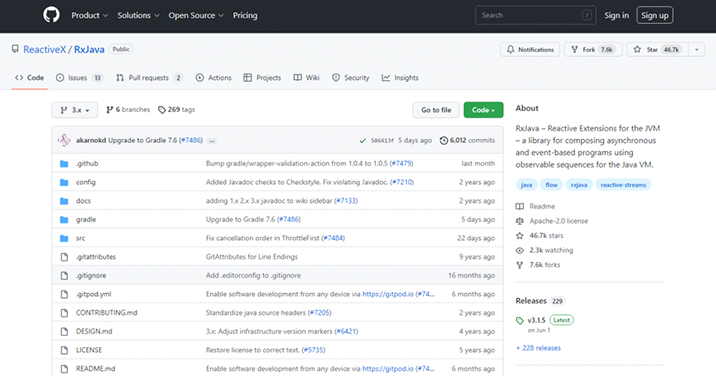
Let’s do a simple Hello World snippet as below.
import io.reactivex.rxjava3.core.*; public class HelloWorld { public static void main(String[] args) { Flowable.just("Hello world").subscribe(System.out::println); } } |
import io.reactivex.rxjava3.core.*; public class HelloWorld { public static void main(String[] args) { Flowable.just("Hello world").subscribe(System.out::println); } }
Another reactive library is Project Reactor. It is based on reactive streams specification and focused on creating non-blocking applications on JVM.
6. Reactive Programming Benefits
Despite its complexity, understanding reactive programming may greatly simplify your job. In that case, how can Rx help while creating software?
Because it can handle large amounts of data fast, Reactive programming is useful to developers for boosting an app’s performance. These components make up Reactive Programming:
- Improved adaptability
- Capable of withstanding pressure and growing in size
- Increased tolerance for setbacks
- Conserve energy and materials
- Not as covert
- Extremely receptive
A lot of attention require to make the reactive programming modules as responsive as possible. Their response to users is both efficient and engaging.
As a result of its tidier structure and greater conciseness, Reactive Programming code is simpler to comprehend and scale. In this approach, it will be easier to make adjustments and updates. Such characteristics bring us to yet another benefit of Reactive Programming: it’s time-efficiency.
In addition to its other benefits, reactive programming provides more robust error handling. It may also be used to apply backpressure, which is a nice bonus. This implies the receiver can direct the publication’s data outflow. This method enables the service to prevent “out of memory” errors and keeps the user-provider traffic flowing smoothly.
7. When to Use Reactive Programming?
Reactive programming is an excellent solution for some sorts of high-load or multi-user applications:
- Networking sites, conversations
- Gaming
- Audio and video application development
And to the preceding elements of any program type:
- Code running on the server that offers out fully engaging UI components
- Load balancing and proxy servers
- Artificial intelligence, machine learning
- Broadcasting data in real time
8. When Not to Use Reactive Programming?
Briefly said, do not attempt to pertain to Reactive Programming when it is unnecessary, such as when there is no “live” data, a heavy load, or a significant number of concurrent users that modify data.
9. General Significance of Reactive Programming
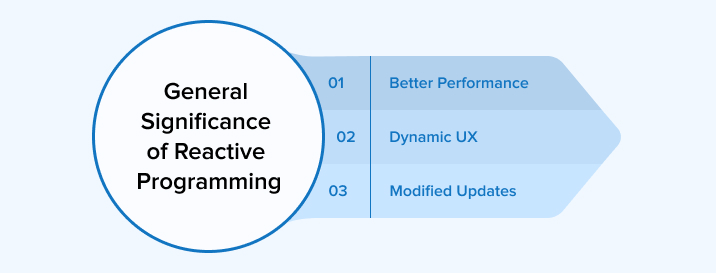
Better Performance
Performance gains, thanks to the ability to quickly and reliably process massive data sets.
Dynamic UX
User experience (UX) is enhanced since it is possible to maintain a state in which the program remains reactive to its user.
Modified Updates
More understandable and predictable code makes it simpler to make changes and updates.
10. Summary
In this post, we’ve taken a high-level, all-encompassing look at the Reactive movement and placed it within the context of today’s business world. There are now several different Reactive libraries and frameworks being developed for the JVM. They have several similar characteristics, and are becoming compatible with one another because of Reactive Streams.
While it may take time and effort to fully grasp the notion and acquire Reactive Programming, the paradigm is immensely beneficial in the modern world. It has a lot of benefits that make development easier, boost app performance, help apps to remain responsive, and ultimately, make users happier. Because of its ability to tailor each user’s experience, user experience (UX) has quickly become a top priority for modern apps.

Vishal Shah
Vishal Shah has an extensive understanding of multiple application development frameworks and holds an upper hand with newer trends in order to strive and thrive in the dynamic market. He has nurtured his managerial growth in both technical and business aspects and gives his expertise through his blog posts.
Subscribe to our Newsletter
Signup for our newsletter and join 2700+ global business executives and technology experts to receive handpicked industry insights and latest news
Build your Team
Want to Hire Skilled Developers?

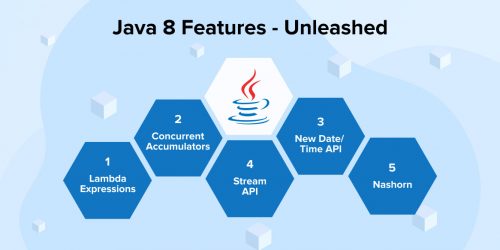
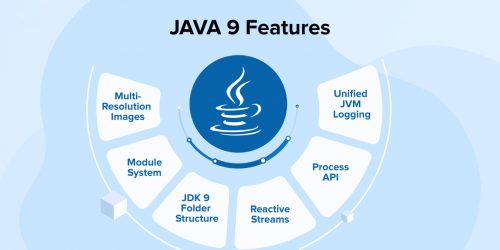


Excellent piece! Your breakdown of Java Reactive Programming is both lucid and succinct. I'm particularly intrigued by your distinction between reactive Programming and Reactive Systems. Keep up the stellar work!
This insightful article comprehensively explores the benefits of Java reactive programming for both applications and businesses, offering a detailed introduction to the reactive programming paradigm. I highly recommend sharing this valuable resource with anyone seeking to expand their knowledge of Java reactive programming.
This is a phenomenal article about reactive programming in Java. It covers the basics of reactive programming as well as its advantages and when to use it. This is one of the most informative and well-written blog posts I've read on Java reactive programming.
This blog is a great introduction to Java reactive programming, and it covers all important concepts. I like the point where the author describes the difference between reactive programming and reactive systems. It's a perfect resource for anyone who is interested in learning more about Java reactive programming.
I had a lot of queries regarding Java Reactive programming, like what it is, why we should use it, what it can achieve, and many other things. However, this blog offers a perfect solution to all of my queries. Keep sharing!
The advantages of Java reactive programming are well-explained in this article, along with the reasons why it has emerged as an effective method for creating modern applications. Thanks for sharing!
Thanks for sharing this valuable resource for developers who are interested in learning about reactive programming in Java. It serves as a useful starting point for further exploration and learning.
Currently, Java reactive programming is a hot topic among developers. Reactive programming comes with many benefits, like boosting an app’s performance, improving adaptability, increasing time efficiency, providing robust error handling, making app development easier, helping apps remain responsive, etc. This information was quite helpful to me. Thank you for sharing.